The Ministry of Defence is putting two newly developed uncrewed maritime systems—Snapper and Wasp—through final testing.
During a Written Question session on 30 January 2025, Luke Akehurst (Labour – North Durham) asked about progress on both systems, referencing remarks from the Defence Secretary’s speech at the ADS Annual Dinner on 28 January 2025.
In response, Maria Eagle, Minister of State at the Ministry of Defence, stated that both Snapper and Wasp are “new uncrewed maritime system[s], which [have] been rapidly developed specifically to support Ukraine.” She added that “The system is currently undergoing final testing and further details will be set out in due course.”
While neither Akehurst’s question nor Eagle’s answer provided exact timelines or specific capabilities, the written exchange highlights the government’s ongoing commitment to advancing maritime technology for Ukrainian support.
Both Snapper and Wasp are described as initiatives designed to bolster defence efforts in Ukraine, though further information on the scope and operational plans remains pending.
Recently, we reported that the Ministry of Defence (MOD) had announced a Project COOKSON Challenge Session back in January. The event invited industry partners from NATO, Ukraine, and Five-Eyes countries to help shape the development of a versatile, fast, and low-observable maritime system designed for operations in Ukraine and beyond.
According to the MOD, “If you have expertise in vessels, vessel launcher systems, surface-surface effectors, counter air effectors, marinised GNSS hardened navigation, sensors, integrators, autonomous systems, or beyond-line-of-sight communications, this session might be of interest to you.”
What is Project COOKSON?
Project COOKSON envisions a small, fast attack vessel equipped with modular payloads and capable of operating in challenging environments. The MOD described the system as follows:
A COOKSON system consists of a small, fast, vessel with low observability, with >2 one-way effectors mounted on it, including relevant launch system and support equipment. A COOKSON system should be able to travel to Ukraine via Ground Lines of Communication (GLOC) [and] must fit onto a 40 foot flatbed, ideally a 20 foot flatbed.”
The vessel is designed for reuse across multiple missions, with modular payloads allowing flexibility for different operational needs. Once deployed in Ukraine, the system will operate autonomously or semi-autonomously to deliver payloads, complete missions, and return to friendly coastlines for re-arming and maintenance.
Operational Objectives
The MOD outlined several critical capabilities for the COOKSON system:
- A top speed exceeding 40 knots, even in Sea State 3 conditions.
- A range of 800 nautical miles fully laden and a minimum endurance of 72 hours.
- Low observability and the ability to operate in GNSS-degraded or denied environments.
- The capability to carry multiple (>2) one-way effectors with a high-explosive warhead and a range of 30–100 km.
- Hard-kill air defence capabilities to counter threats such as rotary-wing aircraft and ISR drones.
The MOD emphasised in the notice to industry, “The COOKSON system will be able to strike a target whilst the vessel and the effector are in a GNSS-denied or degraded environment.”
Concept of Operations
A COOKSON system consists of a small, fast vessel with low observability, equipped with more than two one-way effectors mounted alongside the relevant launch system and support equipment. The system is designed to be transported to Ukraine via Ground Lines of Communication (GLOC) and must fit onto a 40-foot flatbed truck, ideally a 20-foot flatbed.
If necessary, the vessel and effectors can be transported on separate flatbeds. While the ability to move the system by Strategic Air Transport is desirable, it is not essential, and the Ministry of Defence (MOD) can provide support to achieve this. The vessel is intended for reuse across multiple missions, making it distinct from a one-way attack platform.
Once in Ukraine, the COOKSON system will be deployed into a body of water, most likely a sea. At this point, the one-way effectors, if not already loaded, will be attached to the vessel, and it will be prepared for departure. This location will provide basic services, such as fuel, cranes, and the capability to rearm the vessel.
When loaded with its effectors, the COOKSON vessel will travel under its own power to the desired launch location. Target information, including location, will be sent to the vessel remotely. Target acquisition, identification, and mission planning may be conducted by third parties, although industry contributions are welcome.
The operators of the COOKSON system will then prepare the vessel for launching its effectors, potentially doing so remotely. They will verify the system’s functionality through a Built-In Test (BIT). Once confirmed to be operational, the COOKSON effectors will be launched, with all effectors (>2) expected to engage a single target to ensure mission success.
The COOKSON system also includes a requirement for hard-kill air defence capabilities to deter or defeat low-level aerial threats, such as rotary-wing aircraft or ISR (Intelligence, Surveillance, and Reconnaissance) drones.
After completing its mission, the COOKSON vessel will return to a friendly coastline for inspection, maintenance, repair, and re-arming. Ideally, the vessel will be removed from the water for these activities to be conducted on land, ensuring it is ready for subsequent missions.
Effectors in the COOKSON System
Industry Collaboration
The Challenge Session aims to explore key aspects of the COOKSON system’s feasibility, including:
- The trade-offs between crewed versus uncrewed designs.
- Integration of air defence systems, such as 0.50 calibre weapons, MANPADs, or more advanced systems.
- Scalability and production timelines, with a target of 2–3 vessels per month within six months of an order.
The MOD added, “The secondary purpose of the Challenge Session is to enable industry-to-industry networking, ahead of next steps.”


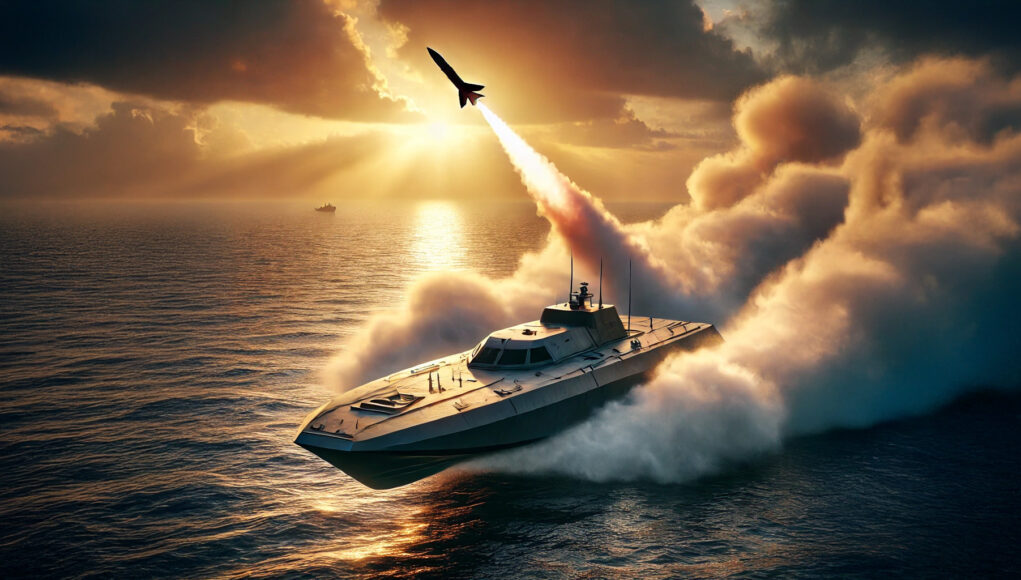
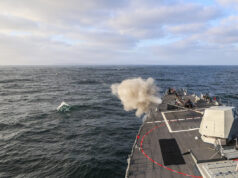
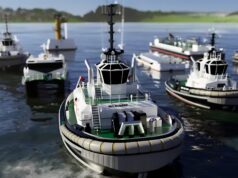
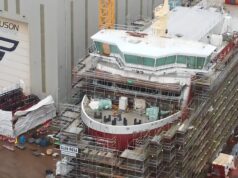
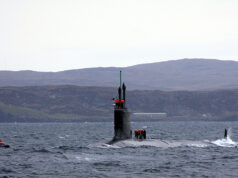
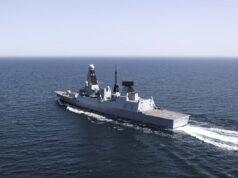

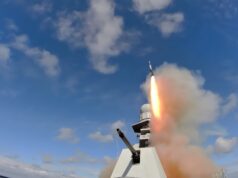
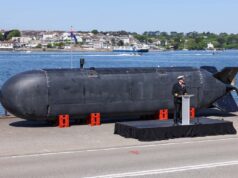
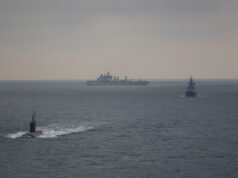
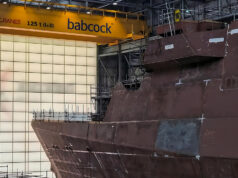

Why does it have windows ?
Because it’s an slop AI generated Image. @George, please hire actual artists if you need illustrations, AI art is just theft.
It’s certainly not a good image at all really, just where was the missile launched from ?
Jim AI rarely makes actually coherent images, since it basically works off of people feeding other peoples work into it, and use it to remix that into something vaguely approximating a prompt. They usually look pretty because people love feeding vibrant artists work that have mastered soft shading (that takes a lot of work to master btw) into them, but once you start looking at details they usually throw up a tonne of question marks.
Or it is a modified vessel COTS?
Given the build speed it is likely to be made using boats that are lying around anyway.
Do we or the Ukrainians actually have any low observable boats lying around though ? Not sure if the article is very clear as to what development stage these craft are actually at.
Sea Baby Drones are built from a small leisure craft hulk and so do not poke out of sea state wave clutter much.
RF navy has proven unable to detect and engage them. So low observation relative to typical RF kit and crew competence, perhaps.
RFN used Mi-8 helicopters to police and intercept Sea Baby so admission to inability of frigates to deal..
It’s not. It’s very obviously a AI generated image. There’s a distinctive soft shade style that AI art tends to gravitate towards, especially on the smoke, and if you look at the hull form, especially around the bow, your brain will start to hurt because AI doesn’t understand how ships are actually shaped.
Yeah, the AI imagery just confuses the matter. I was confused about what the Gravehawk looked like.
I disagree I have started using Ai elements for some of my illustrations I don’t see how it can be called theft any more than me using reference for my non Ai illustrations. Fact is it’s the future and it’s pointless trying to be a Luddite about it, it reminds me of when w3 all started using computers for our design in the 80s and it was called cheating, now few make a living without exploiting it. Fact is now I am able to do work for charitable purposes which I simply could not have done starting painstakingly from scratch and getting an image from prompts is a real skill in itself, it generally takes the drudgery out of constructing my ideas while there is plenty of more enjoyable effort in perfecting it or combining elements thereafter.
As for the image above we know it’s just an imaginary visual guide to attract the eye nothing wrong with that, seems to be some reference to optionally maned systems which may be responsible for the ‘windows’ as one sees in present unmanned test beds too, they may be manually controlled on occasion especially if being taken location to location in a complex environment so it’s not totally pointless for the originator. As for getting George to employ ‘real illustrators’ well I doubt he could afford the expense or times. I do illustrations for online military sites and pretty do it most of the time because I enjoy doing it and can sell the image later in my online shops I certainly don’t remotely make a profit from those commissions and wouldn’t on most occasions even if I used AI produced imagery in support of it. Indeed the only real if modest worthwhile profit was from a German military magazine who wanted to use 8th Airforce Formation ship profiles I had already produced for another site. Sadly there isn’t great profits to be made by all but the top echelon of illustrators these days, those times are long gone.
It’s not “cheating” it’s theft because the way it works is people feed other artists work into the AI in order for it to remix their work and pump out images that are then used to put actual artists out of business. This has been frequently (read almost always) done without the initial artists consent, to the point where you can outright prompt AI image generators to generate things “in the style of x artist.”
So no, it’s not being a luddite, it’s a statement of fact.
“Sadly there isn’t great profits to be made by all but the top echelon of illustrators” gee… maybe it’s because people like George use AI generated crap instead of hiring artists now. Guess what happens once the current generation of top echelon illustrators retire and nobody replaces them because there’s no no way of making money because people like you have referred to anyone who objects to art theft as a luddite?
EO/IR, or that’s what the artist drew, or they aren’t windows.
Yes for some time the Leonardo helicopter drone looked like it had windows or just blacked out ones in various supporting imagery, best to just take it as an image to break up what would otherwise be endless high contrast type that would be mind numbingly boring to churn through to get an idea of what was being discussed. As someone who does mostly existing but generally historical aircraft the time and effort of trying to get them right and remotely accurate is almost endless on top of then actually producing the researched image itself, so I have every sympathy for someone producing an imaginary image of something that we can only fundamentally guess at by the limited information provided, so some latitude should be given. In the end it’s just to enliven an article not be the focus of it.
Nobody produced this. Someone typed a few words into an AI generator and had it churn something out to them. Sympathy is nil.
I’m guessing the AI has to look outside so it doesn’t feel lonely
Now let’s unpack that.. it’s a drone that can travel 800KM, it can then launch 3 other suicide drones ( missiles or other effectors) with a range of up to 100Km …at the same time it will have defences to protect itself from airborne defensive drones…
Essentially the Ukraine war has increased the pace of change in regards to drone inpact on both land and naval warfare..the RN really needs to be very focused on this as it will potentially be able to transform a weakness ( the very late delivery of the new frigate fleet) into a strength..frigates able to very much be the focus of drone based defence and offensive warfare. Because the RN will end up with a whole new fleet of frigates with large mission bays and cranes..perfect for active participation in drone warfare. A type 26 with 2 to 4 of these in its mission bays will be able to support strike 900kms away…and keep striking as long as it has the effectors in its magazines…
Maybe we will get T32 after all.
I’m starting to think we should just scrap the entire official drone program and the never ending four letter acronyms and just let DSTL Heath Robinson the s**t out of it with lots of bespoke drones mad max style.
I think we could end up with quite the arsenal for pennies on the pound. DSTL has managed to get storm shadow to fire from an Su24 for a few quid and it’s good enough to kill S400.
They have managed to get ASRAAM firing from a truck for a few quid.
These feats normally cost hundreds of millions and take years.
Now we getting stealth boat attack drones. Like you say pack 2 or 4 on a T26 or even a dozen on a LSD and you have quite the capability.
Drone development seems to be going to fast for the traditional procurement process, just look at Watch-keeper, time for new ideas.
Hi Jim, you Nailed it, all these big ticket drone projects are obsolete at an increasingly rapid rate, the war in Azerbaijan really kick started all this and the Ukraine invasion it a fire under it. It takes the UK decades to design and build big ticket projects, it seems like we need to rethink our strategy. Let’s hope Tempest has enough flex to succeed.
Too many of us on here, I’ll change my name to Jimmy Jones to avoid any confusion.
Good point, though Britain seems to do its best when we are under imminent risk or supporting others who are. You are right we seem incredibly poor at it outside of that scenario, soon get far too snooty I think because these thinks don’t take endless committees, years of navel gazing, development, changes, upgrades and years of testing before getting into the real world of actually arming units. Goood to see we haven’t lost the Heath Robinson genius mind.
Do you mean that we should have dedicated units specifically for turning out a new prototype or modification in various fields – let’s call it USVs, naval UAVs, air defence systems- every few weeks, with just enough budget to cobble together working systems?
Sounds great, but you forgot to include a link to the job application? I wanna sign up!
Men with beards in sheds
So COOKSON is the next evolution of UA Sea Baby drone that has been armed for self defence against Mi-8 helicopters and instead of the ordinance payload making it a one way Kamikaze has a missile effector payload to enable reusability. Still small and cheap, just not one time use.
Sounds like UK MoD is willing to supply CAMM or similar Effectors, which simplifies the challenge.
The GNSS denied suggests a satellite communication requirement as Inertial Navigation would not enjoy Sea State 3. Given that Starlink is not reliable perhaps OneWorld LEO network will suffice. Inmarsat has low bandwidth by modern standards so probably only suitable for course correction.
Sounds like a lot of fun. Let’s do it!
I’ve got a couple questions.
The ‘effector’ is required to have a warhead of 80kg, however, Brimstone weighs in at about 50-60 kg with a 6 – 7 kg warhead (3 versions) and is and is about 1.8m long, Sea Venom weighs in at 110kg with a 30kg warhead and is 2.5m long so not tiddlers by any means.
The MBDA Germany JFS-M missile has a 80kg warhead but it weighs in at 300kg it also exceeds the range requirements by quite a margin and is supersonic. Regardless a 80kg warhead is going to need a sizeable missile to accelerate it up to flight speed and get it out to the 30-100km required. Problem one does MBDA have something ready to go? Problem two – 40 ft boat is going to be heavily loaded with one of these things on board let alone 2 and as for a 20ft boat – really..?
So have I missed something..?
Cheers CR
Presumably named after ‘Catherine’.
Got to say CR that similar thoughts were going through my mind, though until you spelled it out I hadn’t realised just how tough a combination it looks like having to achieve. Will be interesting to see what comes out of it. I would have thought as this seems to be something of a Seababy on steroids concept that they would know from the Ukranians what is generally possible and that knowledge taken and expanded upon.
Hi Spyinthesky,
Good point about the Ukrainians experience, mate.
When I first read about this in the previous article my first thought was Brimstone as the ‘effector’. That seemed like a good size / weight match for the size of boat being specified, add in 40knots, 800 miles range, stealth and a hard kill AA system and I felt that it all added up to a lot for such a small hull. When I looked at missile warhead combinations this time round it seemed that they are asking for the modern equivalent of a twin 15″ gun turret..!
Joking aside, what happened to keeping it simple, easy to produce in numbers and quickly..?
I’d keep the boat size as is, that’s sensible, but I’d spec an off the shelf Brimstone sized weapon as Ukraine has experience with that system. I would spec 2 or more rather than more than 2, and I would settle for a soft kill AA system, 35knots top speed but retain the 800miles range to give the design team room to make sensible design trade off’s.
I also note that the article said that the MoD would supply the ‘warheads’ which struct me as a bit odd. Given the boat is supposed to be reusable how are they going to get the warhead to the target which is 30 to 100km away from the launch point? Guidance is needed for that kind of range which pushes us toward a complex missile system or perhaps a suicide drone..? It might be possible to have drones launched from the platform, hence the supply of warheads..? Drones don’t need launch canisters, don’t have boasters so no need for blast deflectors etc. So drones stored under a set of hatches might work.
You never know they might actually pull it off. If they do I’ll be well impressed and can we order a bunch for the RN.
Cheers CR
The rise of the robots or Roberts is starting. Fortunately it seems AI is water cooled so just turn the tap off or if it’s Thames Water supplied there will be a leak and Pooooooof no more nasty AI.